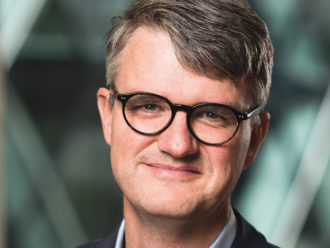Border to Coast’s chief investment officer tells Andrew Holt about change management, building trust, taking the expensive option, the next big thing in China and his concerns with ESG data.
What was at the top of your in-tray when you became chief investment officer three years ago?
The key for me, as well as building relationships with the team, was making sure we had the right supporting resources, so building out our research and risk functions. That meant building a dedicated team of research professionals.
Building that functionality allowed [the funds] to take bigger positions and be more active with their risk expression. And, consequently, have more quantitative support on portfolio construction, risk management and understanding the exposures.
I was also focused on getting our alternatives platform up and running as soon as possible. That will have material cost savings for our partner funds of about £12m a year.
Even more interesting than smaller fees for the alternatives platform, is giving our partner funds access to a global range of strategies and geographies that they could not invest in before. They did not have the teams, especially the smaller funds, to bypass the fund of funds and negotiate fees directly.
Hiring has also been big. In 2018, we had only 15 staff who had transferred from our partner funds to set up Border to Coast. In three years, we have grown to around 100 employees, with about 50 on the investment side. So, we have built the team and supplemented our resources. There has been a lot of stakeholder engagement with our partner funds.
Pooling is a big change management programme requiring a lot of trust and building relationships. So, the executives at Border to Coast, including myself, have done a lot of travelling to see pension committees and meet the officers. A lot of engagement has been involved.
Where are you with the alternatives platform?
We have raised almost £6bn, which is about twice what we expected. About £4bn of that has been deployed, so we have been pretty busy. It will be fully committed by next spring.
Infrastructure, private credit and private equity are the three main sleeves. Within that we are covering all sub strategies and geographies: so, we have Chinese healthcare and Brazilian infrastructure – things our partner funds could not have done by themselves.
Why did you leave Aramco to join Border to Coast?
It is not every day that you get to build a £55bn asset manager from scratch, with long-dated capital and long-dated liabilities.
Most of the UK’s pension industry is de-risking, so cannot do interesting things. We have inflation-linked liabilities, open plans and long-dated liabilities, so we should be managed differently and be more focused on return-seeking assets to minimise the cost of funding.
This is the third start-up asset management company I have been involved in but is by far the most complex in terms of the scale, timeframe and the amount of stakeholders – 11 partner funds. So, we have to bring the councils, politicians, advisers and consultants along with us while we are building something.
What are your key objectives?
To make Border to Coast compete with the Canadians and some of the other more sophisticated international plans. I also want to improve the risk-adjusted performance over time.
How do I do that? One, risk-balanced portfolios, to make sure we are not overly concentrated to any one outcome but can perform reasonably well in different environments and scenarios. Two, give access to the right funds and strategies. Three, to do this all on competitive terms.
Another is building a sustainable organisation and having a strong team around me, so it is not reliant on one key person and that there are multiple leaders in the team.
Then there is making sure we are integrating ESG and the climate transition into the investment process in a sensible manner. We want to be engaging and
improve standards, as opposed to divesting, which is passing the problem to someone else. So, being an active voice on that front.
What does your current investment portfolio look like?
We have about £25bn of active equity and fixed income on the platform. About half of that is internally managed with the rest through funds. That is a legacy preference some of our partner funds have: some prefer internal and some external, but we are also thinking about where it is appropriate to do internal management versus external management.
For example, our investment grade credit portfolio is managed externally with competitive costs from the market. I could have built that slightly cheaper internally, but the risk of building a top quartile internal team for the cost savings was not an attractive trade off. So we went for a marginally more expensive option, which helped get it up and running quickly and select the best-in-class managers.
We have about 10 funds at the minute – all fundamentally active strategies. As I mentioned, we have three alternative sleeves, with £5.7bn in assets, of which about 40% is allocated to infrastructure with around 30% each to private credit and private equity.
We are launching a couple of funds: multi-asset credit and listed alternatives, which will take another £5bn to £6bn active exposure into the pool over the next quarter.
And we are in the process of working through the real estate investment trust (REIT) transition [amendments to the UK REIT rules] and how that works, and we will eventually be one of the biggest holders of UK real estate.
What do you find attractive in the investment markets?
It is more a case of what is not attractive: and what is not attractive is cash. You are going to get a negative real return holding cash over the next five years. So, on a relative value basis, a diversified pool of assets looks attractive versus cash, albeit they may not be that attractive versus their own respective histories.
We have seen a sharp recovery from the Covid crisis, which has been induced by the injections from central banks and treasuries, which have driven up valuations. Most assets are fully valued, but the relative valuations versus cash is an important component.
There are some asset classes: emerging market equities are a slightly cheaper valuation versus developed and the currencies also look slightly cheap. So, for a long-term investor that could be something to be aware of. Chinese equities have underperformed year-to-date, so a starting point for a long-term investor looks slightly more attractive. Credit spreads have come down and are relatively tight.
Across the alternatives we are seeing valuations that are expensive, but if you pick your points, we are trying to focus on specialised strategies where there is added operational value as opposed to taking market beta. The market we are going into is a much more dispersed market – you have to be a bit more selective. There may be a few things that are cheaper than others, but I would not say there is anything that screams value.
You also have funds focused on China, what is your interest there?
I have been investing onshore in China since 2005 and in the private markets for the past 10 years. We have private strategies in China through our alternatives programme.
One of the areas we are focused on in the country is healthcare, which we believe will be a new trend over the next vear to 10 years. If you look back at the past 10 years, you had to be invested in technology – over the next 10 years it will be healthcare, which we have been exposed to for the past five years.
On the equity side, we split out our Emerging Market Equity fund into a hybrid fund. So, we were managing that in-house and what we have done is take the non-China element and retained that for in-house management, but the China element was outsourced to external managers.
We did this because the non-China element is going to be overweight large cap quality, so we want the China element to be in high growth innovative companies. We wanted a local partner who understands the market and can spot high-growth companies.
Are you seeing similar opportunities in the US?
We also see a hub of innovation, of technological-driven changes there. We are quite active in the venture space in the US in the private programme and have managers on the equity side.
What will be the challenges in your portfolio going forward?
There is a big push for investors to divest. If you divest you lose your ability to influence and pass on the problem to other people. We want to engage with companies and improve standards across the board and across all our programmes.
So, we are active on the corporate side, on equity and bonds, but also in the alternative space, through our own endeavors as well as working with our consultant to improve standards in the alternatives industry, which are at an earlier stage than the traditional asset managers. Asset owners have a big role to play and are, in many respects, ahead of the asset mangers.
What is a decent timeframe to engage? A year? Five years? 10 years?
The most important thing is a willingness to listen and understand what the issues are as well as a willingness to respond and proactively work with us and our partners. We want to be a collaborative asset owner with the industry and the underlying companies.
How important is ESG to Border to Coast?
ESG is not a separate discipline. It has always been integrated into the investment process. It is now just a bit more explicit. ESG is a risk factor we review and assess when making investments. We do it at a position level in our internal research templates.
So, when we are selecting bonds or equities, we have a section on responsible investing and ESG as part of that investment template to assess those criteria. We do quarterly benchmarking at the portfolio level for our internal and external mandates on ESG and carbon metrics.
ESG and climate data is important to you. Is this a simple case of what gets measured gets managed?
Data quality is an issue for everybody. A lot of carbon readings are implied, so the correlation between a company’s actual numbers and implied numbers is pretty low.
On carbon, it is self-reported. There are no standards or oversight. So, you could be rewarding companies for aggressive assumptions and penalising those that are conservative – which is the opposite of the behaviour you want to promote.
If you look at the G in ESG, research from Cambridge University shows that there is no correlation between the FTSE and MSCI’s governance scores. This is quite shocking as it should be the easiest of the three pillars of ESG. So, data quality needs a lot of work. That is why we have internal teams to sift through the data and understand the readings.
Is inflation a concern?
It is a big concern for our partners funds as they have inflation-linked liabilities. So, by default, it is a concern for us. I have been highlighting for the past year that we are going to see an uptick in inflation. We have record amounts of quantitative easing, record amounts of household cash on balance sheets and record amounts of corporate cash on balance sheets at a time when we have supply side constraints and potentially the unwinding of more long-term trends, such as corporate taxes going up, ESG costs going up and labour costs going up through greater equality and better working standards.
This massive amount of liquidity will drive changes in cyclical trends, which will push up inflation. We have seen inflation rise in the first part of this year and the second part of the year is going to be elevated because of supply side constraints. My estimation is we will have high inflation going into 2022.
That presents challenges. On the equities front, the immediate impact is higher earnings, which we are seeing. The next impact is a squeeze on margins, which we are starting to see. The eventual impact is that people want to pay lower multiples for cash flows, as inflation moves higher.
The big unknown is how central banks will react in 2022 and what impact that will have on the economy – how accommodative or aggressive they are going to be.
In our alternatives programme, we are prioritising assets with inflation linkage. In our equity programmes we are looking at companies with pricing power that can pass costs through so the margins do not get squeezed too much and we are aware of the potential impact of factor exposures: so higher inflation and higher rates probably favour value stocks over growth stocks.
It is a big issue for our underlying pension plans. They are well funded, but a couple of years of 5% inflation could remove those surpluses quite quickly.
What are your investment aims?
To be careful not to de-risk too quickly because assets should outperform cash. Although we are going into a more difficult investment environment, de-risking too quickly will be negative for long-term returns. Assets are expensive, but cash even more so.
We will be building out on our alternatives programme: we have saved 35 basis points, or £12m, a year through the alternatives programme, but we are only just starting to ramp up our current investments. We have quite a big pipeline and now have the team to deal with that. It will be a source of savings for our partner funds and a source of capital going forward, especially on the infrastructure side where we are going to be particularly active.
We also want to continue to integrate responsible investing and ESG into the investment process. We have done a good job of integrating them, but you can always do more. We want to be ahead of new regulations not behind or in line with them as well as understand the data better.
On active equity and fixed income, we tend not to take too much factor risk and are focused on selecting stocks which could be more sustainable in the longer term, while being aware of the macro drivers that could affect the underlying companies.
And making sure we have good risk management, which is essential, as local government pension schemes have historically had less focus on risk management than the corporate sector.
Why is this?
They have viewed risk from a different perspective as they are long-term investors. Corporate schemes are more focused on the quarterly earnings impact and are a little more sensitive to how it impacts their reporting. There are pros and cons here, but we want a high level of risk sophistication.
What plans do you have in the pipeline?
We are excited by what we are going to launch on real estate. On the global front, most of our partner funds do not have access to real estate, so that will be a new offering for them next year.
Global real estate is interesting because of the diversification benefits. Real estate is a local market. It is about the supply and demand in that local market, but equity markets are globalised.
In the UK market, we have a mix of direct and indirect funds and are going to allow those indirect funds to access real estate cost effectively. That will be a good cost saving for [the partner funds] over the long term. We will be one of the biggest holders of UK real estate in the future once we have finished the transition.
We are also launching a multi-asset credit fund, which gives funds access to high-yielding loans, bonds, emerging markets, local currency dollars, sovereigns, corporates and securitised credit. A few of our partner funds have multi-asset credit funds, but few have good coverage across the board in those asset classes. So, this opens up a new income stream.




